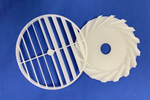Braskem Expanding into the 3D Printing Market
In 2020, Braskem launched polypropylene for fused filament fabrication, SLS powder bed fusion, and industrial scale pellet extrusion.

PP filament from Braskem.
Last year, Braskem announced the expansion of its product portfolio to include polyolefin-based filament, powder, and pellets for the additive manufacturing market.
The company says that polypropylene is ideal for additive manufacturing based on its recyclability, impact strength, chemical resistance, and dimensional stability that has durable living hinge capabilities as well as a lower density than existing polymers such as PLA. These properties make polypropylene an attractive material for a wide range of 3D printing applications. Braskem also invested in a new dedicated additive manufacturing lab as part of an expansion of its Innovation & Technology (I&T) Center located in Pittsburgh.
“Braskem has been observing the 3D printing ecosystem closely and as we watched the market grow, this was hard to ignore,” said Jason Vagnozzi, Braskem additive manufacturing leader, North America. “We started to evaluate how we can add value to the marketplace, which lead us down the path of PP in this journey.”
Braskem has developed two grades of polypropylene filament for fused filament fabrication (FFF). These materials are designed to be used for both industrial and personal printing applications. They were made available May 2020 through a distribution partnership with M. Holland Co.
In 2019, Braskem also announced its first partnership to advance the development of polypropylene powder for Selective Laser Sintering (SLS) with Advanced Laser Materials (ALM), an EOS company. Braskem and ALM released their first generation polypropylene powder in May 2020, where it is co-marketed and sold as part of the ALM product portfolio. Titan robotics and Braskem launched the first commercially available grade of polypropylene for their Atlas industrial scale pellet extrusion system. Braskem's polypropylene for pellet extrusion also became commercially available in May 2020.
“We saw the market struggle to try to convert traditional reactor grade PP into a functional filament,” Vagnozzi said. “Existing PP filaments on the market would warp and have issues with bed adhesion, so we developed a custom formulation specifically designed for 3D printing to overcome those issues, and saw amazing results.”
The company’s PP line can be used for prototyping and end-use applications. Vagnozzi said the company is seeing a lot of traction in aerospace, industrial and automotive applications.
“What we have done in 2020 gives us the confidence to move forward to expand product offerings in 2021,” he said. “We’re going to take the knowledge we gained with our base PP grades and start incorporating fiber with PP to get a higher performance. That’s the next frontier for Braskem.”
In addition to fiber, Braskem is experimenting with incorporating PCR PP in its base PP filament, with using anywhere from 5-15% recycled content.
“That is something we are actively looking at,” Vagnozzi said.
Related Content
-
Freeform Injection Molding Eases the Path to Medical Device Product Testing
A development and manufacturing service provider is using dissolvable molds to build injection molded silicone prototypes.
-
KraussMaffei Launches Two Additive Manufacturing Lines at K 2022
Long established in injection molding, extrusion and polyurethane reaction process machinery, 184-yr-old KraussMaffei prepares to enter the industrial additive manufacturing market.
-
Additive Fusion Technology Optimizes Composite Structures for Demanding Applications
9T Labs continues to enhance the efficiency of its technology, which produces composite parts with intentionally oriented fibers.
















